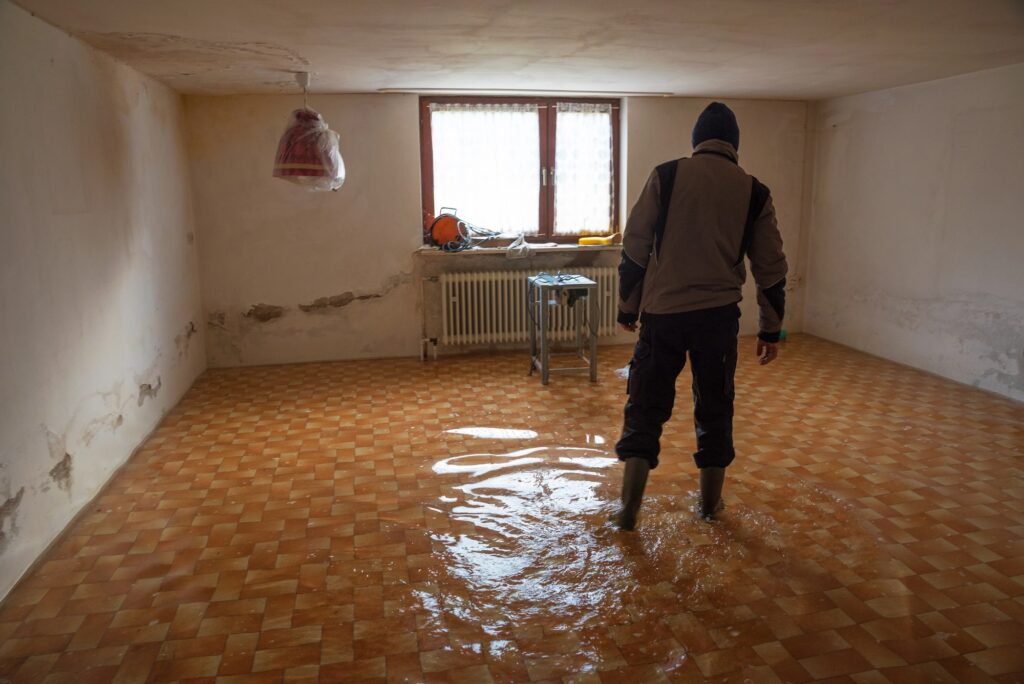A flooded basement is a shock no homeowner ever wants to face. Water sneaking into your basement can quickly wreck your stuff, ruin floors, and even threaten your home’s structure. What you do in those first few moments after you spot a flood really matters—it can save you money, stress, and maybe even keep your family safer.
You might be surprised by how fast things can spiral if you don’t jump in right away. Water seeps into walls, causes mold, and leads to repairs that are nobody’s idea of fun. Knowing how to clean up, dry out, and fix your basement helps you dodge bigger headaches later. Having a simple plan makes the whole mess feel a little less overwhelming.
Not sure where to start? There’s plenty of advice from folks who’ve been through basement floods. This guide’s got practical steps, info on where to get help, and ways to protect your home for next time.
Causes of a Flooded Basement
There are a handful of ways water can end up in your basement. Each has its own warning signs and some simple ways you can keep your home safer and drier.
Heavy Rainfall and Storms
Big storms or days of rain mean lots of water crowding around your house. If your yard doesn’t drain well, all that water can push through the dirt and sneak into cracks in your basement walls or floor.
Basements are especially at risk if your lot sits low or if your gutters and downspouts aren’t doing their job. Water can pool right up against the foundation, pressing in and letting moisture leak inside.
If your yard slopes toward the house, you’re way more likely to get a flooded basement during storms. Watch for puddles near your walls and make sure downspouts shoot water at least 6 feet away.
Plumbing Failures
Busted pipes, old water heaters, and clogged drains can fill a basement with water in no time. Plumbing fails for all sorts of reasons—frozen pipes, aging fixtures, or loose joints. Even a slow leak can do real damage over time, but a bigger break can flood the place in minutes.
Washing machines are another culprit. If a hose pops, water keeps spraying until you shut it off. Main sewer backups are even worse—they can push dirty water up through drains and toilets.
It’s worth checking pipes, hoses, and your water heater every year. Look for rusty pipes, water stains, or sudden drops in water pressure.
Foundation Cracks
Even a tiny crack in your basement wall or floor can let water in when it rains. Groundwater will find any weak spot. Cracks can grow over time from settling, tree roots, or just bad construction.
Once water finds a way through, it can make the crack worse and set you up for long-term trouble. Mold loves hidden, damp spots. Small cracks might not be a big deal, but bigger ones or any that let water in should be fixed quickly.
Seal small cracks with special products. Bigger issues may need a pro. Keep an eye on any crack and watch for changes.
Sump Pump Malfunctions
Sump pumps are supposed to keep water out, but they can let you down at the worst time. Power outages, clogged lines, stuck switches, or a pump that’s just too small can all spell trouble.
Without a working pump, even a regular rain can fill up the pit and spill water into your basement. No battery backup? If the power goes, so does your pump.
Maintenance matters. Clean the pit every few months. Make sure the pump kicks on when water rises. Test your backup system if you have one.
Effective Flooded Basement Solutions

Taking the right steps can prevent extra damage and protect your home. Quick water removal, thorough drying, and cleaning all help lower repair costs and health risks.
Immediate Water Removal Steps
Speed matters. The longer water sits, the worse things get. For deep water, use a pump or wet/dry vac. Smaller puddles? Mops and buckets work.
Put on rubber boots and gloves for safety. Flip off the electricity in the basement to avoid shocks. Move out furniture, rugs, and anything valuable to keep them safe.
If a pipe burst, shut off your home’s water supply right away. If there’s sewage or chemicals, don’t go in—call a pro.
Drying and Dehumidification
Once the water’s out, drying fast stops mold. Open windows and doors to get air moving. Use fans and dehumidifiers if you have them. Bigger fans and dehumidifiers work best.
Pull out wet drywall, insulation, and flooring—they hold moisture and can grow mold. Lift carpet and padding, dry them outside if you can. Move boxes and tools somewhere dry.
Check moisture in walls and floors with a meter if you have one. Basements can take several days to dry out. Keep fans and dehumidifiers running until everything feels dry. Even when it looks dry, let the equipment run a bit longer to be sure.
Cleaning and Sanitizing
After drying, you’ll want to clean up to prevent health issues from bacteria and mold. Scrub floors, walls, and shelves with hot, soapy water. Disinfect using a cup of bleach in a gallon of water. Keep the area well-ventilated while you work.
Wear gloves and a mask to protect yourself from cleaners and germs. Use a stiff brush for tough spots. Toss out anything porous that soaked up dirty water—it’s almost impossible to clean.
Don’t forget corners, cracks, and behind appliances—these spots stay wet longer and get missed.
Restoring Damaged Materials
Some things can be saved, others just need to go. Remove and replace wet drywall, carpet, padding, and insulation—those materials trap moisture and grow mold.
Treat wet wood floors or framing with a mold-killer. Let wood dry fully before you seal or cover it. Hard plastic or metal can usually be cleaned and reused.
Fix cracks in walls or the foundation to keep water out next time. If you’re rebuilding, think water-resistant materials like vinyl flooring or special drywall. Seal up windows, doors, and any gaps to stay dry in the future.
Frequently Asked Questions
How can I prevent my basement from flooding?
Keep your gutters clean and make sure water flows away from your house. Install a sump pump and check it now and then. Seal any cracks in the foundation and use window well covers to help stop leaks.
Is it safe to live in a house with a flooded basement?
Honestly, it’s not a great idea. Floodwater can carry germs, chemicals, even sewage. Mold can start in just a day or two, making things riskier. It’s important to get the water out and dry the place as soon as possible.
Who to call about a flooded basement?
Call a water damage restoration company for cleanup and drying. If you’ve got home insurance, contact your provider to see if you’re covered.
How long to dry out a basement after a flood?
Honestly, it varies. Drying out a basement after a flood depends a lot on just how much water made its way in and how fast you jump into cleanup. For most folks, it’ll take somewhere between a couple of days and up to a week. Fans, dehumidifiers, and letting some fresh air in—those really do make a difference and can get things back to normal a bit faster.
